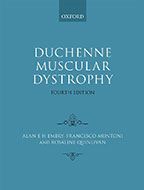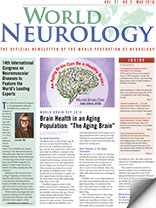Alan EH Emery, Francesco Muntoni, and Rosaline Quinlivan
Oxford University Press
271 Pages

John F. Brandsema, MD
In the preface of their 4th edition, the authors recall the necessity of a second edition being published only a year after their first in 1987, due to the isolation and cloning of the dystrophin gene and the identification of its protein product. The subsequent 25 years have seen an explosion of research in both basic science and clinical medicine regarding the biochemical underpinnings and the clinical management of Duchenne muscular dystrophy (DMD), a broad field that is expertly and concisely summarized in the current edition.
This trim (roughly 270 pages plus references) and well-written textbook by a highly respected group of neuromuscular clinicians in England is a pleasure to read. The flow is excellent, with little of the repetitiveness or ambiguity of thought that can occur in multi-author endeavors. There is a fascinating exploration of the history of DMD, from the first depictions of what is believed to be muscular dystrophy in Ancient Egyptian hieroglyphics to acknowledgement by the authors of prominent contemporaries in the field today. Complex concepts and topics regarding the biochemistry and genetics of DMD are conveyed in a concise and clear manner, with supportive data largely drawn from the vast clinical experience of the authors themselves.
 There were very few aspects of the book that disappointed me as a reader who specializes in care of pediatric neuromuscular disorders, and none were overly striking. While all figures are interpretable regarding what they are meant to illustrate, many of the pathology figures in particular would be much better appreciated in color rather than the black and white version in the text. A color section of the text or an online color supplement would greatly augment the reader’s appreciation of the beautiful examples selected for presentation regarding the pathology of DMD. The recommendation to perform muscle biopsy in every patient for direct dystrophin studies, in addition to molecular genetics, is somewhat strongly worded for the current practice of most of today’s neuromuscular clinics. However, the authors do temper this by emphasizing in other sections of the text the particular populations where this can be especially useful, such as a young patient with an identified dystrophin gene mutation which has previously been reported as having variable phenotypic expressions. It is also easily appreciated that the multi-systemic management issues in older Duchenne patients are complex: in the text, topics such as spinal surgery and cardiopulmonary management are dealt with rather briefly, in contrast to the more extensive discussion of musculoskeletal management of the ambulant child with DMD, for example. These are all minor points, and none was jarring enough to detract from the book’s many admirable qualities.
There were very few aspects of the book that disappointed me as a reader who specializes in care of pediatric neuromuscular disorders, and none were overly striking. While all figures are interpretable regarding what they are meant to illustrate, many of the pathology figures in particular would be much better appreciated in color rather than the black and white version in the text. A color section of the text or an online color supplement would greatly augment the reader’s appreciation of the beautiful examples selected for presentation regarding the pathology of DMD. The recommendation to perform muscle biopsy in every patient for direct dystrophin studies, in addition to molecular genetics, is somewhat strongly worded for the current practice of most of today’s neuromuscular clinics. However, the authors do temper this by emphasizing in other sections of the text the particular populations where this can be especially useful, such as a young patient with an identified dystrophin gene mutation which has previously been reported as having variable phenotypic expressions. It is also easily appreciated that the multi-systemic management issues in older Duchenne patients are complex: in the text, topics such as spinal surgery and cardiopulmonary management are dealt with rather briefly, in contrast to the more extensive discussion of musculoskeletal management of the ambulant child with DMD, for example. These are all minor points, and none was jarring enough to detract from the book’s many admirable qualities.
Overall, this book is impressive in its scope. The timeliness of any textbook suffers somewhat from the time delay related to its publication schedule, but the discussion of therapeutic trials in this text, addressing both genotypic and phenotypic modification of DMD, nicely introduces most of the concepts still actively being studied today. Another particular strength is the unblinkingly honest and insightful discussion of sensitive topics, such as disclosing a diagnosis of DMD, and psychological problems in boys with DMD and their families. These aspects of DMD management are essential to excellent care, but are less often addressed in scientific publications about DMD.
In summary, I strongly recommend this book as a natural addition to the library of any clinician who specializes in treating neuromuscular disorders, and it would be of interest to anyone who may encounter patients with DMD in their practice, including physical/occupational therapists, nurses, genetic counselors, social workers, dietitians, neurologists, physiatrists, geneticists, cardiologists, pulmonologists, orthopedists, and more. As the field of research related to DMD continues to evolve at a rapid pace, hopefully another edition will soon update discoveries and advances.
